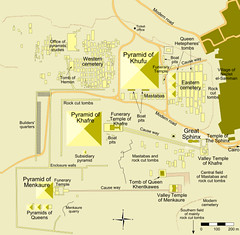The Great Pyramid of Giza (also called the Pyramid of Khufu and the Pyramid of Cheops) is the oldest and largest of the three pyramids in the Giza Necropolis bordering what is now El Giza, Egypt, and in a historical irony is the oldest of the Seven Wonders of the Ancient World and the only one that survives substantially intact.
It is believed the pyramid, says Wikipedia, was built as a tomb for fourth dynasty Egyptian Pharaoh Khufu (Cheops in Greek) and constructed over a 20 year period concluding around 2551 BC.
The Great Pyramid was the tallest man-made structure in the world for over 3,800 years. Originally the Great Pyramid was covered by casing stones that formed a smooth outer surface, and what is seen today is the underlying core structure. Some of the casing stones that once covered the structure can still be seen around the base.
There have been varying scientific and alternative theories regarding the Great Pyramid's construction techniques. Most accepted construction hypotheses are based on the idea that it was built by moving huge stones from a quarry and dragging and lifting them into place.
skip to main |
skip to sidebar
For students and parents who love education and exploration of the social sciences . . .
Search This Blog
Followers
Blog Archive
-
▼
2010
(346)
-
▼
March
(51)
- What's surprising and significant in the compariso...
- Thurs, Ap 1: Vietnam plus Korea map quiz as well a...
- Korea: another nation divided between communist an...
- Orienting ourselves to the Pacific rim nations
- Review of Presidents in Vietnam project
- Thanks for supporting the Class of 2013 Magnet Tal...
- Informal presidential review . . .
- Vietnam: 58,000 US dead, some 4 million Vietnamese...
- 1972, South Vietnam: the Victims Of War
- Shot Heard Around The World: Execution of a Viet C...
- Due Thurs: Colorful map of Vietnam
- Vietnam and the Chinese, French and the US: a hist...
- In-class project: Four presidents and US involveme...
- The largest and most technologically advanced ship...
- Indie work: briefly compare the war in Iraq and Vi...
- Vietnam veteran interview due Mon, Ap 5; 15 pts
- Washington to Hanoi: Vietnam review
- Sitar & Tabla: the unusual musical instruments of ...
- Indie work deadline Sun, Mar 14, noon, for this 9 ...
- Eric Johnson's Gandhi project: effective digital d...
- Freshman Talent Show: Wed, Mar 24, 6:30 pm, PAC; i...
- Shreveport's Hindu Cultural Center since 2006
- Western world stress relief: Hatha Yoga from India
- Gandhi's tactics: use media, the law, Christianity...
- Watching the movie Gandhi for useful quotes . . .
- India: land of many cuisines
- Gandhi map project due Thurs; 15 pts
- Sari vs kimono and other indie comparison topics
- The 78-year journey of Mohandas Karamchand Gandhi
- Mumbai / Bombay: one of the world's most populous ...
- Slumdog Millionaire and other recommended movies o...
- India: Land of Curry, land of Hinduism
- Indie work: comparison essays on . . .
- The Ankh: symbol of eternal life
- March named for Roman god of war & fertility: Mars
- Pharaoh Hatshepsut, female ruler about 1500 BCE of...
- Egyptian overview: from the Pharaonic period to th...
- What to know on a map of Aegypticus (the Roman/Lat...
- A highlighter: the tool to use as you review notes...
- Egypt map and textbook activities
- The Nile
- West African music
- West African studies
- Walk like an Egyptian, The Bangles
- Gift of the Nile: Egypt
- Abu Simbel: massive mountainside temples in Southe...
- Memphis was the first capital of Egypt
- The columns of the Luxor Temple, near Karnak
- The Great Pyramids were built during the Old Kingdom
- Sphinxes
- The Great Pyramid of Giza (of Khufu), the Great Sp...
-
▼
March
(51)

